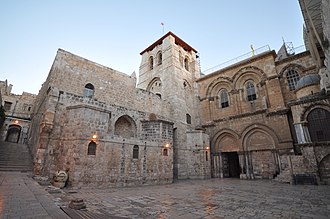In his famous book The New Knighthood: A History of the Order of the Temple Malcom Barber reconstructs in detail the birth of the Order. He argues that it is probable that, prior to their recognition by King Baldwin II sometime after Spring 1118, the brotherhood that later became the Knights Templar existed in another form. Prior to settlement on the former royal palace at the Temple Mount and becoming "The Poor Fellow-Soldiers of Christ and of the Temple of Solomon" (in Latin: Pauperes commilitones Christi Templique Salomonici), this brotherhood probably already existed for some years as one of the brotherhoods of the Holy Sepulcher.
Researching on this TN found that one of the possible groups was the Canons Regular of the Holy Sepulchre. Originally, a canon was a cleric living with others in a clergy house or, later, in one of the houses within the precinct of or close to a cathedral and conducting his life according to the orders or rules of the church. This way of life grew common (and is first documented) in the eighth century. In the eleventh century, some churches required clergy thus living together to adopt the rule first proposed by Saint Augustine that they renounce private wealth. Those who embraced this change were known as Augustinians or Canons Regular, whilst those who did not were known as secular canons.
The also Augustinian Order of the Canons Regular of the Holy Sepulchre was founded in the Church of the Holy Sepulchre in Jerusalem, then the capital of the Kingdom of Jerusalem. The Order was recognised in 1113 by Papal bull of Pope Paschal II and therefore must have been established several years earlier.
According to the website of the Latin Patriarchate of Jerusalem Godfrey de Bouillon, who ruled Jerusalem between July 15, 1099 and his death on July 18, 1100, founded the Order of Canons of the
Holy Sepulchre. According to accounts of the Crusades, in 1103 the first
King of Jerusalem, Baldwin I, assumed the leadership of this canonical
order.
The Order’s members included not only the Regular Canons (Fratres) but
also the Secular Canons (Confratres) and the Sergentes. The latter were
armed knights chosen from the crusader troops for their qualities of
valour and dedication. They vowed to obey Augustinian Rule of poverty
and obedience and undertook specifically, under the command of the King
of Jerusalem, to defend the Holy Sepulchre and the Holy Places. This description seems a blueprint for the later Knights Templar Order.
The Order of the Canons Regular of the Holy Sepulchre was suppressed in 1489 by Pope Innocent VIII, but its history runs parallel to that of the Equestrian Order of the Holy Sepulchre of Jerusalem (along with the Knights of the Holy Sepulchre of the Custody of the Holy Land), with Grand Magistery vested in the Papacy since 1496.
sources Wikipedia 1 and 2, and LPJ. illustration Church of the Holy Sepulchre Wikipedia

No comments:
Post a Comment